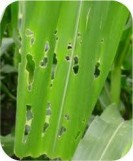Philemon Buruzi
Recent media reports of an armyworm outbreak in parts of Mashonaland Central and Midlands provinces made uneasy reading for most maize growers. Given the trail of destruction that the armyworm can leave one can only pray that the outbreak does not spread further. I found it timely that I share a few facts surrounding the armyworm with fellow maize farmers with the hope that this can assist us to detect the presence of armyworm in our crops early enough to enable containment.
The armyworm is a migratory moth whose larva (caterpillar) stage presents a deleterious crop pest when environmental conditions favour their rapid breeding to an extent that they occur in very large numbers. Armyworms feed on all cereal crops, pasture grasses and sugarcane. Owing to their tendency to occur in large numbers, these caterpillars can destroy an entire crop in a short space of time.
Identification
The armyworm caterpillars occur in two forms which are characteristic of their respective population densities. Here is to mean that when young all the caterpillars are the same colour (i.e green) and they transform into different shades in accordance to their nature of occurrence. Those that occur in low population densities (solitarious) tend to assume a variety of shades mostly green-brown or pink, with a pale speckled head. They tend to be fat, and are extremely sluggish, actively avoiding the sun and sheltering and feeding at the base of grasses. These do not cause much problems to our crops.
On the other hand armyworms that occur in large numbers (gregarious) become blackish as they mature. When fully grown (i.e 4cm in length), they assume a velvety-black colour on the upper body surface with interspaced by green, yellow and white lateral stripes. When handled up-side-down the underside they exhibit a green or yellow underside. They have no hairs at all and their heads are shiny black (see image below). Unlike the those described earlier these ones are very active, and tend to feed on the aerial parts of the plant avoiding the shade. It is this gregarious version that is problematic to the farmer.
.

Control
Effective control measures can be put in place if a farmer is able to identify the armyworms correctly. Further if the armyworms are still too few or too little to be seen easily, the farmer should be able to tell from the manner in which the leaves are damaged as follows: Young armyworms scrape out the tissue of one side of the leaves creating a 'window' effect(see (a)below); leaves may dry up and assume a scorched appearance whilst older worms feed on leaves starting at the margins and moving inwards, leaving the leaves with a ragged appearance. They may eat whole leaves leaving only the midrib (see(b) below).


(a) (b)
Farmers in areas that normally get affected by armyworms are encouraged to be on the lookout by carrying out regular scouting exercises in order to detect the presence of the armyworm early enough.
Scouting is done as follows:
-randomly select 5 different spots on the maize field
-in each of the 5 spots examine 20 maize plants for either leaf damage or the presence of the larvae
- record the number of affected plants in your field and easily use this to compute the percentage of the stand damaged.
This exercise should be carried out early in the morning or at dusk in order to observe the full activity of the larvae.
Since in Zimbabwe armyworm outbreaks illicit national response, it is advisable that if a farmer detects armyworms , a report should be made to the authorities in order to control the worms before they get out of hand. Carbaryl has always been used effectively to contain armyworm outbreaks and it is normally supplied by the government. If the chemicals are not in place and you notice that the armyworms are advancing towards your field you can plough a ditch right round the field and keep it filled with water. Alternatively one can dig adeep ditch with vertical sides to trap the caterpillars and prevent them from crawling out. Dig a hole, adiameterof a fence post, in every 10 meters within the ditch. Caterpillars are lured to congregate in the holes. Collect and properly dispose the trapped caterpillars.
Experts from the Plant Protection Research Institute state that the reprieve from new outbreaks prevailing is temporary as it has been caused by the heavy rains that fell and disrupted the infestations. However if drier weather prolongs there is good chance that new cases will be recorded, so in the meantime all maize farmers should continue scouting their field especially those who are tendering a late planted crop.
For all questions and comments: philemonburuzi@gmail.com. Responses will be provided within the shortest possible time.

